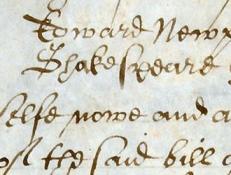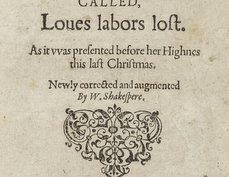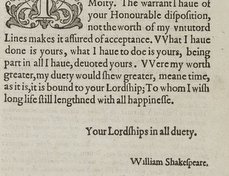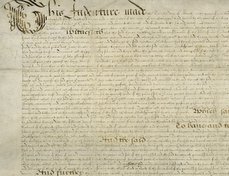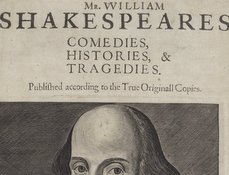Images reproduced by permission of The National Archives, London, England.
Terms of use
The National Archives give no warranty as to the accuracy, completeness or fitness for the purpose of the information provided.
Images may be used only for purposes of research, private study or education. Applications for any other use should be made to The National Archives Image Library, Kew, Richmond, Surrey TW9 4DU, Tel: 020 8392 5225 Fax: 020 8392 5266.
Document-specific information
Creator: Court of Chancery
Date: May 22, 1615
Repository: The National Archives, Kew, UK
Call number and opening: C 33/127, fol. 1074r
View online bibliographic record
In 1613 William Shakespeare, with the assistance of three trustees, purchased the gatehouse in the Blackfriars neighborhood of London, evidently as an investment. As a new owner, Shakespeare was entitled to receive any and all legal instruments (or paperwork) associated with the property, including indentures of earlier purchases. Only by having all such instruments in his possession could an owner defend against rival claimants. But Shakespeare had acquired the gatehouse without its associated documents. In fact he was the fifth of six owners of Blackfriars properties who went to court with the very same problem on April 26, 1615. The Decree of Chancery shown here is the final judgment, the final step of a lawsuit, and is dated May 22, 1615.
The lawsuit was evidently a simple legal maneuver undertaken with friendly intent, and Bacon agreed to turn over the associated documents:
It is threvppon ordered that the said defendant shall bringe into this Corte all the said letters Patentes deedes evidences writinges mynumentes soe by him Confessed to be in his custodye or possession vpon his oath here to remayne to be disposed of as shalbe meate and for that purpose the plaintifes maye take proces against the defendant if they will.
Bendish et al. v. Bacon provides incidental verification of William Shakespeare’s ownership of property in Blackfriars. Although the lawsuit does not explicitly mention his acquisition in 1613 of Blackfriars gatehouse, it does reveal that Shakespeare took an active interest in his London property a year before his death in April 1616, an interest even more explicitly mentioned in his will.
[This transcription is pending final vetting]
[Transcriber’s note: while the original contains little or no punctuation, punctuation marks have been added to enhance comprehensibility.]
[Transcription begins at mid-page.]
[Centered]xxijde die Maij
[Left margin] B.
[Left margin:] Robinson / Heringe
[Left margin] Thomas Bendishe knight & Baronet Edward Newporte et alii placitori Matheus Bacon generosus defensor
Whereas this Courte was this presente daie informed
by Mr Richard Moore beinge of the plaintiffs Counsell
that the said plaintiffs beinge seised in ffee of and
in one Cappitall messuage with the
appurtenances scituate in Blackfryers didheretofore Come to, ^and that divers the letteres Patentes, deedes, evidences, Charters,
mynumentes, and writinges concerninge the same ^did heretofore come vnto the custodye of Iohn Anne
Bacon the defendants mother as executrix to her mother whoe latelie dyed and made the defendant her executor,
and that by meanes thereof the said letteres Patentes, deedes, evidences, and
Charters, mynumentes, and writinges are nowe Come vnto his hands, for obteyning
whereof the said plaintiffs have exhibited there bill into this Courte, wherevnto the
defendant, having Aunswered, doth by his said Aunswere Confesse that one
letters Patentes and certeyne deedes, evidences, & writinges, & mynumentes concerning
the said messuages and premisses in the bill mencioned are come into his
handes and possession, the said defendant not makinge any Title therevnto, but
desiringe that he maye be orderlie dischardged thereof vpon delivery of
the same as this Courte should thincke fitt, and therefore It was desired
that the said letters Pattentes and others the deedes, evidences, and writinges soe
Confessed might be brought into this Courte vppon the defendants oath. It is
therevppon ordered that the said defendant shall bringe into this Courte
all the said letters Patentes, deedes, evidences, writinges & mynumentes soe by
him Confessed to be in his custodye or possession, vpon his oath here to
remayne to be disposed of as shalbe meete, and for that purpose the plaintiffs
maye take proces against the defendant if they will.
…
To learn more, read Alan H. Nelson's essay on lawsuits in Shakespeare's England.
Written by Alan H. Nelson
Sources
E.K. Chambers, William Shakespeare: A Study of Facts and Problems, vol. 2 (Oxford: Clarendon Press, 1930) 2:159-161; 164-164
B. Roland Lewis, The Shakespeare Documents (Stanford University, California: Stanford University Press, 1940), 2:467-71.
Samuel Schoenbaum, William Shakespeare: A Documentary Life (New York: Oxford University Press, 1975), 223-4.
David Thomas, Shakespeare in the Public Records (London: H.M.S.O., 1985), 38.
Last updated August 9, 2018


